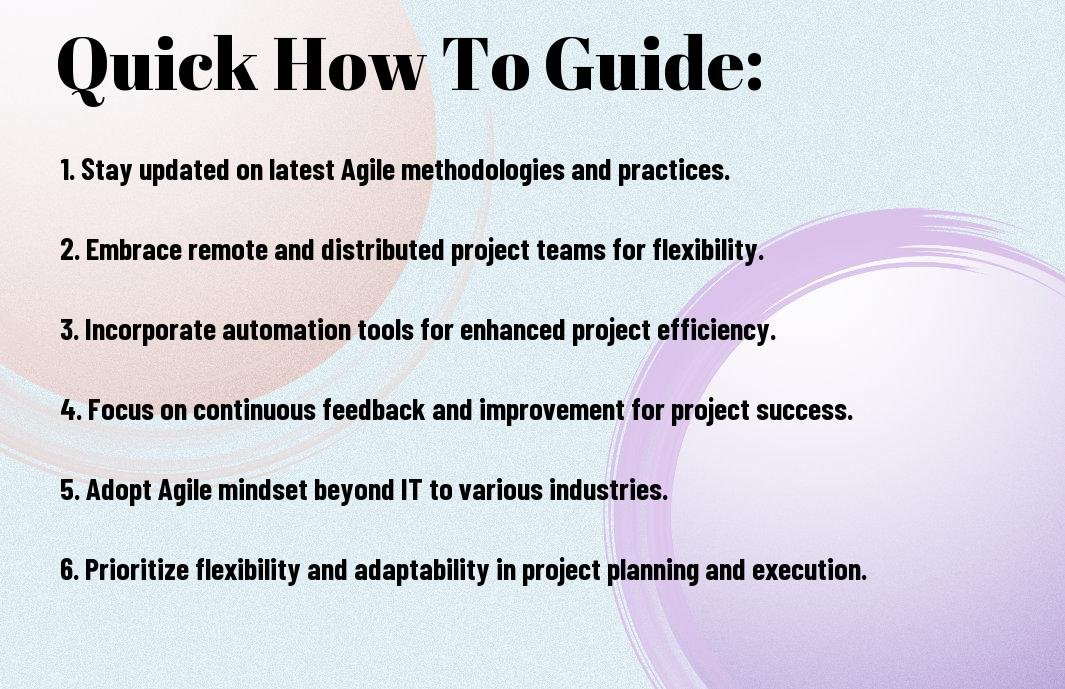Agile project management is constantly evolving, with new trends shaping its future. Keeping up with these trends is crucial for staying ahead in the game. In this blog post, we will explore the most important developments in the world of Agile project management and highlight key positive changes to watch out for. To further understand the landscape of project management, check out The future of hybrid project management: Trends and challenges.
Key Takeaways:
- Focus on Business Value: Agile project management is shifting towards a greater emphasis on delivering business value over adhering strictly to project timelines and budgets.
- Hybrid Agile Approaches: Organizations are adopting hybrid agile approaches that incorporate elements of different methodologies like Scrum, Kanban, and Lean to better suit their project needs.
- Remote and Distributed Teams: With the rise of remote work, agile project management is adapting to cater to the needs of remote and distributed teams by leveraging virtual communication tools and collaboration platforms.
- AI and Automation: The integration of artificial intelligence and automation tools is transforming agile project management by streamlining processes, improving decision-making, and enhancing productivity.
- Continuous Learning and Improvement: Embracing a culture of continuous learning and improvement is becoming crucial in agile project management to stay competitive and adapt to evolving trends and technologies.
How to Stay Ahead of the Curve in Agile Project Management
Tips for Embracing Emerging Trends
A key aspect of staying ahead in Agile Project Management is being adaptable and open to new trends. To embrace emerging technologies and methodologies, teams should prioritize continuous learning and experimentation. Keeping up with industry developments through conferences, webinars, and networking can provide valuable insights for implementing innovative practices. Perceiving changes in the environment and being willing to adjust project management strategies accordingly is imperative for success.
Factors to Consider When Adopting New Methodologies
When adopting new methodologies in Agile Project Management, it is crucial to consider various factors. The team dynamics, organizational culture, and project requirements play a significant role in determining the suitability of a new approach. Stay informed about the potential risks and benefits of the methodology being considered and assess its compatibility with the current project landscape. Ensure adequate training and support mechanisms are in place to facilitate a smooth transition.
When introducing a new methodology, it is imperative to conduct pilot projects to gauge its effectiveness in real-world scenarios. The feedback received from these trials can help in fine-tuning the implementation process and addressing any challenges that arise.

The Rise of Artificial Intelligence in Agile
How AI Can Enhance Project Planning and Execution
Little by little, Artificial Intelligence (AI) is making its way into Agile project management. AI can offer valuable insights by analyzing data trends, forecasting potential risks, and even suggesting optimal scheduling for project tasks.
Tips for Integrating AI into Your Agile Workflow
Rise to the challenge of incorporating AI into your Agile workflow by considering these tips:
- Train your team on AI implementation.
- Start with pilot projects to test AI capabilities.
- Use AI tools for data visualization and analysis.
After integrating AI into your Agile workflow, you may see enhanced efficiency and improved decision-making processes.
The Evolution of Remote Work and Virtual Teams
Factors to Consider When Managing Distributed Teams
Now, as remote work becomes more prevalent, project managers need to consider several factors when managing distributed teams.
- Communication: Ensure clear and regular communication channels are in place.
- Technology: Utilize collaboration tools for seamless project management.
- Time Zones: Account for different time zones to schedule meetings effectively.
- Cultural Differences: Understand and respect diverse cultural norms within the team.
Knowing these factors can help project managers successfully navigate the challenges of managing remote teams.
How to Foster Collaboration and Communication in a Virtual Environment
To foster collaboration and communication in a virtual environment, project managers should prioritize establishing trust among team members and encouraging active participation. Virtual team-building activities, regular virtual meetings, and utilizing collaboration tools can enhance communication and strengthen team bonds. An open-door policy and encouraging feedback can also contribute to a more collaborative virtual environment. Knowing how to foster collaboration and communication is key to the success of virtual teams.

The Importance of Data-Driven Decision Making
Tips for Collecting and Analyzing Project Data
Keep data collection consistent across all project phases to ensure accuracy. Utilize project management tools to streamline data collection and analysis. Regularly update and review project data to stay informed about progress and potential issues.
- Consistent data collection
- Utilize project management tools
- Regularly update and review data
After implementing these tips, you can make better informed decisions based on reliable project data.
How to Use Data to Inform Agile Project Management Decisions
Project data analysis can guide decision-making by providing insights into performance metrics, identifying risks, and highlighting areas for improvement. Utilize trends and patterns in the data to predict future outcomes and adjust project strategies accordingly.
Data-driven decisions lead to more successful project outcomes and help teams adapt quickly to changing circumstances.
Conclusion
With this in mind, it is clear that Agile project management is here to stay and will continue to evolve with new technologies and trends. Keeping an eye on remote work, AI integration, and scalable Agile frameworks will be crucial for businesses to stay competitive in the ever-changing landscape of project management.
FAQ
Q: What is Agile Project Management?
A: Agile Project Management is an iterative approach to managing projects that focuses on delivering high-quality results quickly while adapting to changing requirements.
Q: What are the key principles of Agile Project Management?
A: The key principles of Agile Project Management include customer collaboration, responding to change, individuals and interactions over processes and tools, working products over comprehensive documentation, and embracing change.
Q: What are some current trends in Agile Project Management?
A: Some current trends in Agile Project Management include scaling Agile practices across organizations, incorporating DevOps practices for seamless delivery, integrating AI and machine learning for data-driven insights, and focusing on Agile leadership and culture.
Q: How is Agile Project Management evolving for the future?
A: Agile Project Management is evolving for the future by embracing remote and distributed teams, incorporating hybrid project management approaches, leveraging new technologies for automation and collaboration, and promoting continuous learning and improvement.
Q: What are some challenges organizations may face when implementing Agile Project Management?
A: Some challenges organizations may face when implementing Agile Project Management include resistance to change from traditional project management methods, lack of clear communication and alignment across teams, difficulties in scaling Agile practices, and balancing flexibility with project deadlines.







